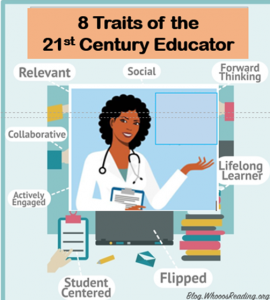
John Dewey – – a 20th-century American philosophy, psychologist, and educational reformer whose ideas have been influential in education and social reform.
This quote is still truly relevant today! and reinforces why “innovation” is so important in today’s teaching.
My classroom innovations and quality of instruction to enhance student learning are informed by reviewing the literature, staying abreast of current trends, and engaging in pedagogical workshops and conferences.

These “Qualities of an Effect 21st Century Educator” identified by Mike Daugherty speaks to the importance of innovation in the classroom. To me, innovation involves forward-thinking and being transformational. We must be willing to change and evolve in order to prepare nursing students for success as the world is changing. COVID-19 brought major changes and challenges to how classes were taught and highlighted the importance of being innovative.
- Student-Centered
- Actively Engaged – Authentic learning happens when the students are actively engaged in their learning
- Flipped – Flipping the classroom goes hand and hand with engaging the students
- Forward-thinking – How best to prepare nursing students for success in this changing world.
- Relevant – Modern educators look to stay relevant with students by adapting their lessons to include the use of technology and social media
- Social – Social media and mobile technology is embraced in the classroom
- Lifelong Learner – NEVER stop learning
- Collaborative – We must work together. Create and share lesson plans. Importance of professional development
******************************************************************************************************
Virtual Clinical (Spring Semester 2020)
Nursing of Women and the Childbearing Family – Clinical (50:705:302)
As the course coordinator for Nursing of Women and the Childbearing Family (50:705:301), I created and implemented a ‘Virtual Clinical’ process to meet part of the clinical obligations for the course. In the spring semester of 2020, we were faced with not having enough quality women’s health sites to meet the clinical needs of about 180 students enrolled in the course.
Virtual clinical consisted of utilizing maternity ATI modules and videos to actively engage and expose students to women’s health concepts to foster their knowledge and critical thinking skills regarding various maternal and newborn care. The virtual clinical process ensured that students were exposed to the same clinical concepts they would have encountered in clinical, which help to foster consistency among the students.
I divided each clinical group into two sub-groups (Group A and Group B). Each group alternated between actual clinical and virtual clinical. For example, on week one, clinical sub-group A was engaged in in-person clinical within the hospital and clinical sub-group B completed virtual clinical at home during the same designated clinical time. The following week, sub-group A would then complete the virtual clinical assignments at home and sub-group B would then be engaged in in-person clinical within the hospital. The same clinical faculty were assigned to both sub-groups and remained in place each week at the clinical site, only the student sub-groups alternated each week between in-person clinical and virtual clinical. The virtual clinical modules were monitored by a designated course assistant to check and ensure modules were completed as assigned by their due dates. However, the clinical faculty were encouraged to review and follow-up with actual patients and experiences in clinical whenever possible.
The rotation of students between in-person and virtual clinical was also cost-effective because we only needed half the number of clinical faculty (*).Each clinical faculty was assigned the same 2 sub-groups that alternated between in-person and virtual each week.
Additionally, in March 2020, when the COVID-19 pandemic forced schools to switch to virtual learning and hospitals stopped allowing students to have their in-person clinical, students in this course had a seamless transition to a completely virtual structure. Introducing this innovative virtual structure at the beginning of the semester allowed students to become familiar with virtual clinical and adjust to this type of learning before the pandemic. This approach supported students to continue to meet the clinical objectives of the course with minimal disruption. (*11 clinical faculty with 2-groups of 8 students each)
- ATI Maternity Modules to use with Virtual Clinical_2020_WILLIAMS
- ATI Modules_Virtual Clinical Assignments_Spring 2020
- VirtualClinical_A.B_MATERNITYROTATION.2020
Boot Camp (Spring Semester 2020)
As the course coordinator for Maternity, I implemented a Pre-Clinical Boot Camp the week before the start of classes and clinical. The implementation of the pre-clinical boot camp was a team effort, with all theory faculty assisting with the implementation and success of this program. Dr. Jamille Nagtalon-Ramos worked with the Simulation lab to set-up the stations and to print the packets for the students. The purpose of the boot camp was to orientate and prepare the students to key skills and concepts related to maternity prior to clinical. Students were rotated through 7-skill stations with a focus on reviewing basic terminology, practice using medical equipment, and demonstrate fundamental skills related to the care of childbearing women and newborns. The students were required to get each station checked off to complete their individual Clinical Passport.
Samples of my VoiceThread lectures:
- DNP: Women’s & Perinatal (58:705:669) – Perimenopause & Menopause
-
DNP: Women’s & Perinatal (58:705:669)- Diagnostic Test & Screening in Pregnancy
Technology in society is a large part of today’s environment; therefore, I have incorporated the use of YouTube videos, Socrative, and other web-based programs into most of my courses. Below are some examples from my classes:
YouTube videos I use in maternity to reinforce concepts taught in class.
Khan Academy – Educational videos that I assign students to review to reinforce concepts from class.

In the Fall of 2015, I integrated MyNursingLab into the Nursing of Women and the Childbearing Family (57:705:301) course as a process to encourage more student participation in their own learning and to strengthen their knowledge of the material. I did observe an increase in grades in this cohort compared to former student cohorts as well as an increase in-class participation. However, due to the cost to the students, I discounted the use of this program (students must purchase a new book to use this product).
Adobe Spark Videos – allow students to create videos to discuss or illustrate assigned topics. More interactive than a PowerPoint presentation.
Students’ Adobe Spark Videos from Seminar on Professional Nursing (50:705:101):
-
“Should Nurses Be Mandated to Get a Flu Shot” by Hannah Palo, My Huynh & Michael Graham
-
Nursing Code of Ethics. Created by Allyson Enriquez, Judy Castillo, Emily Quirk
Socrative – a simple web-based, mobile-friendly, assessment tool that allows educators to create quiz-type content and engage students through quick formative assessment questions or team competitions. Students who may be unlikely to raise their hands in class have an opportunity to respond digitally and anonymously
- I embedded NCLEX questions throughout the lecture to assess students’ knowledge, which also offers me the opportunity to reinforce or re-explain key concepts.
I also use Quizizz & Kahoot as well to test students’ knowledge in a fun, non-threatening way.